A Facile Approach to Increasing the Foliage Retention of Pesticides Based on Coating with a Tannic Acid/Fe3+ Complex
Abstract
1. Introduction
2. Materials and Methods
2.1. Materials
2.2. Methods
2.2.1. Preparation of Az-WDG-TA and Av-WDG-TA with TA/Fe3+ Coatings
2.2.2. The Morphological Characteristics of Particles
2.2.3. Sustained Release Kinetics of Avermectin and Azoxystrobin Formulations
2.2.4. Biological Activity Tests of Avermectin and Azoxystrobin Formulations
2.2.5. The Wettability of Foliage by the Avermectin and Azoxystrobin Formulations
2.2.6. Retention Rates of Avermectin and Azoxystrobin Formulations
2.2.7. Assessing Photodegradation
2.2.8. Statistical and Analysis
3. Results and Discussion
3.1. Morphological Characterization of Avermectin and Azoxystrobin WDG Formulations
3.2. Sustained Release Kinetics of Avermectin and Azoxystrobin WDG Formulations
3.3. The Photodegradation of Avermectin WDG Formulations
3.4. The Effects of Encapsulation on Contact Angle and Retention
3.5. The Biological Activities of Avermectin and Azoxystrobin WDG Formulations
4. Conclusions
Author Contributions
Funding
Conflicts of Interest
References
- Gerber, L.C.; Koehler, F.M.; Grass, R.N.; Stark, W.J. Incorporating microorganisms into polymer layers provides bioinspired functional living materials. Proc. Natl. Acad. Sci. USA 2012, 109, 90–94. [Google Scholar] [CrossRef] [PubMed]
- McGuire, S.; FAO; IFAD; WFP. The State of Food Insecurity in the World 2015: Meeting the 2015 International Hunger Targets: Taking Stock of Uneven Progress; FAO: Rome, Italy; Oxford University Press: Oxford, UK, 2015. [Google Scholar]
- Balaure, P.C.; Gudovan, D.; Gudovan, I. Nanopesticides: A new paradigm in crop protection. In New Pesticides and Soil Sensors; Elsevier: Amsterdam, The Netherlands, 2017; pp. 129–192. [Google Scholar]
- Carvalho, F.P. Agriculture, pesticides, food security and food safety. Environ. Sci. Policy 2006, 9, 685–692. [Google Scholar] [CrossRef]
- Bradberry, S.M.; Proudfoot, A.T.; Vale, J.A. Poisoning due to chlorophenoxy herbicides. Toxicol. Rev. 2004, 23, 65–73. [Google Scholar] [CrossRef] [PubMed]
- Ghormade, V.; Deshpande, M.V.; Paknikar, K.M. Perspectives for nano-biotechnology enabled protection and nutrition of plants. Biotechnol. Adv. 2011, 29, 792–803. [Google Scholar] [CrossRef] [PubMed]
- Malaj, E.; Peter, C.; Grote, M.; Kühne, R.; Mondy, C.P.; Usseglio-Polatera, P.; Brack, W.; Schäfer, R.B. Organic chemicals jeopardize the health of freshwater ecosystems on the continental scale. Proc. Natl. Acad. Sci. USA 2014, 111, 9549–9554. [Google Scholar] [CrossRef]
- Schreiner, V.C.; Szöcs, E.; Bhowmik, A.K.; Vijver, M.G.; Schäfer, R.B. Pesticide mixtures in streams of several European countries and the USA. Sci. Total Environ. 2016, 573, 680–689. [Google Scholar] [CrossRef]
- Yang, X.; Chen, L.; Li, Y.; Xi, W.; Chen, L. Rule-based land use/land cover classification in coastal areas using seasonal remote sensing imagery: A case study from Lianyungang City, China. Environ. Monit. Assess. 2015, 187, 449. [Google Scholar] [CrossRef]
- Stein, K.F. Silent Spring (1962); Houghton Mifflin: New York, NY, USA, 2012. [Google Scholar]
- Nuruzzaman, M.; Rahman, M.M.; Liu, Y.; Naidu, R. Nanoencapsulation, nano-guard for pesticides: A new window for safe application. J. Agric. Food Chem. 2016, 64, 1447–1483. [Google Scholar] [CrossRef]
- Wang, B.; Song, J.L.; Zeng, A.J.; Liu, Y.J.; Zhang, J.; He, X.K. Effects of formulations and surfactants on the behavior of pesticide liquid spreading in the plant leaves. Chin. J. Pestic. Sci. 2012, 14, 334–340. [Google Scholar]
- Allagui, A.; Bahrouni, H.; M’Sadak, Y. Deposition of Pesticide to the Soil and Plant Retention during Crop Spraying: The Art State. J. Agric. Sci. 2018, 10, 12. [Google Scholar] [CrossRef]
- Zhang, M.; Zhu, Z.; Yuan, S.; Wang, S.; Yang, C.; Dwivedi, P.; Si, T.; Xu, R.X. One-step microencapsulation and spraying of pesticide formulations for improved adhesion and sustained release. J. Microencapsul. 2019, 36, 649–658. [Google Scholar] [CrossRef] [PubMed]
- Yu, M.; Yao, J.; Liang, J.; Zeng, Z.; Cui, B.; Zhao, X.; Sun, C.; Wang, Y.; Liu, G.; Cui, H. Development of functionalized abamectin poly (lactic acid) nanoparticles with regulatable adhesion to enhance foliar retention. RSC Adv. 2017, 7, 11271–11280. [Google Scholar] [CrossRef]
- Autumn, K.; Liang, Y.A.; Hsieh, S.T.; Zesch, W.; Chan, W.P.; Kenny, T.W.; Fearing, R.; Full, R.J. Adhesive force of a single gecko foot-hair. Nature 2000, 405, 681–685. [Google Scholar] [CrossRef] [PubMed]
- Chung, H.; Glass, P.; Pothen, J.M.; Sitti, M.; Washburn, N.R. Enhanced Adhesion of Dopamine Methacrylamide Elastomers via Viscoelasticity Tuning. Biomacromolecules 2011, 12, 342–347. [Google Scholar] [CrossRef]
- Darwin, C. The Movements and Habits of Climbing Plants; John Murray: London, UK, 1875. [Google Scholar]
- Federle, W.; Riehle, M.; Curtis, S.A.; Full, J.R. An Integrative Study of Insect Adhesion: Mechanics and Wet Adhesion of Pretarsal Pads in Ants. Integr. Comp. Biol. 2002, 42, 1100–1106. [Google Scholar] [CrossRef]
- Yang, F.L.; Li, X.G.; Zhu, F.; Lei, C.L. Structural Characterization of Nanoparticles Loaded with Garlic Essential Oil and Their Insecticidal Activity against Tribolium castaneum (Herbst) (Coleoptera: Tenebrionidae). J. Agric. Food Chem. 2009, 57, 10156–10162. [Google Scholar] [CrossRef]
- Lee, H.; Dellatore, S.M.; Miller, W.M.; Messersmith, P.B. Mussel-inspired surface chemistry for multifunctional coatings. Science 2007, 318, 426–430. [Google Scholar] [CrossRef]
- Lee, H.; Rho, J.; Messersmith, P.B. Facile conjugation of biomolecules onto surfaces via mussel adhesive protein inspired coatings. Adv. Mater. 2009, 21, 431–434. [Google Scholar] [CrossRef]
- Postma, A.; Yan, Y.; Wang, Y.; Zelikin, A.N.; Tjipto, E.; Caruso, F. Self-polymerization of dopamine as a versatile and robust technique to prepare polymer capsules. Chem. Mater. 2009, 21, 3042–3044. [Google Scholar] [CrossRef]
- Cheng, C.; Li, S.; Nie, S.; Zhao, W.; Yang, H.; Sun, S.; Zhao, C. General and biomimetic approach to biopolymer-functionalized graphene oxide nanosheet through adhesive dopamine. Biomacromolecules 2012, 13, 4236–4246. [Google Scholar] [CrossRef]
- Xiong, X.; Liu, Y.; Shi, F.; Zhang, G.; Weng, J.; Qu, S. Enhanced Adhesion of Mussel-inspired Adhesive through Manipulating Contents of Dopamine Methacrylamide and Molecular Weight of Polymer. J. Bionic Eng. 2018, 15, 461–470. [Google Scholar] [CrossRef]
- Hollon, N.G.; Arnold, M.M.; Gan, J.O.; Walton, M.E.; Phillips, P.E. Dopamine-associated cached values are not sufficient as the basis for action selection. Proc. Natl. Acad. Sci. USA 2014, 111, 18357–18362. [Google Scholar] [CrossRef] [PubMed]
- Yang, L.; Han, L.; Jia, L. A novel platelet-repellent polyphenolic surface and its micropattern for platelet adhesion detection. ACS Appl. Mater. Interfaces 2016, 8, 26570–26577. [Google Scholar] [CrossRef] [PubMed]
- Riedl, K.M.; Hagerman, A.E. Tannin—Protein complexes as radical scavengers and radical sinks. J. Agric. Food Chem. 2001, 49, 4917–4923. [Google Scholar] [CrossRef]
- Serrano, J.; Puupponen-Pimiä, R.; Dauer, A.; Aura, A.M.; Saura-Calixto, F. Tannins: Current knowledge of food sources, intake, bioavailability and biological effects. Mol. Nutr. Food Res. 2009, 53, S310–S329. [Google Scholar] [CrossRef]
- Li, B.X.; Wang, W.C.; Zhang, X.P.; Zhang, D.X.; Ren, Y.P.; Gao, Y.; Mu, W.; Liu, F. Using coordination assembly as the microencapsulation strategy to promote the efficacy and environmental safety of pyraclostrobin. Adv. Funct. Mater. 2017, 27, 1701841. [Google Scholar] [CrossRef]
- Kim, B.-S.; Lee, H.-i.; Min, Y.; Poon, Z.; Hammond, P.T. Hydrogen-bonded multilayer of pH-responsive polymeric micelles with tannic acid for surface drug delivery. Chem. Commun. 2009, 4194–4196. [Google Scholar] [CrossRef]
- Proust, A.; Matt, B.; Villanneau, R.; Guillemot, G.; Gouzerh, P.; Izzet, G. Functionalization and post-functionalization: A step towards polyoxometalate-based materials. Chem. Soc. Rev. 2012, 41, 7605–7622. [Google Scholar] [CrossRef]
- Decher, G.; Schlenoff, J.B. Multilayer Thin Films: Sequential Assembly of Nanocomposite Materials; John Wiley & Sons: Hoboken, NJ, USA, 2006. [Google Scholar]
- Guo, J.; Ping, Y.; Ejima, H.; Alt, K.; Meissner, M.; Richardson, J.J.; Yan, Y.; Peter, K.; Von Elverfeldt, D.; Hagemeyer, C.E. Engineering multifunctional capsules through the assembly of metal-phenolic networks. Angew. Chem. Int. Ed. 2014, 53, 5546–5551. [Google Scholar] [CrossRef]
- Shen, Y.; Du, C.; Zhou, J.; Ma, F. Application of nano FeIII-tannic acid complexes in modifying aqueous acrylic latex for controlled-release coated urea. J. Agric. Food Chem. 2017, 65, 1030–1036. [Google Scholar] [CrossRef]
- Shen, H.; Duan, C.; Guo, J.; Zhao, N.; Xu, J. Facile in situ synthesis of silver nanoparticles on boron nitride nanosheets with enhanced catalytic performance. J. Mater. Chem. A 2015, 3, 16663–16669. [Google Scholar] [CrossRef]
- Zou, Y.; Guo, J.; Yin, S.-W.; Wang, J.-M.; Yang, X.-Q. Pickering emulsion gels prepared by hydrogen-bonded zein/tannic acid complex colloidal particles. J. Agric. Food Chem. 2015, 63, 7405–7414. [Google Scholar] [CrossRef] [PubMed]
- Yang, L.; Han, L.; Ren, J.; Wei, H.; Jia, L. Coating process and stability of metal-polyphenol film. Coll. Surf. A Physicochem. Eng. ASP 2015, 484, 197–205. [Google Scholar] [CrossRef]
- Yao, J.; Cui, B.; Zhao, X.; Wang, Y.; Zeng, Z.; Sun, C.; Cui, H. Preparation, characterization, and evaluation of azoxystrobin nanosuspension produced by wet media milling. Appl. Nanosci. 2018, 8, 297–307. [Google Scholar] [CrossRef]
- Chen, M.; Jensen, S.P.; Hill, M.R.; Moore, G.; He, Z.; Sumerlin, B.S. Synthesis of amphiphilic polysuccinimide star copolymers for responsive delivery in plants. Chem. Commun. 2015, 51, 9694–9697. [Google Scholar] [CrossRef]
- Wang, C.; Guo, L.; Yao, J.; Wang, A.; Gao, F.; Zhao, X.; Cui, B. Preparation, characterization and antifungal activity of pyraclostrobin solid nanodispersion by self-emulsifying technique. Pest Manag. Sci. 2019, 75, 2785–2793. [Google Scholar] [CrossRef]
- Bo, C.; Chunxin, W.; Xiang, Z.; Junwei, Y.; Zhanghua, Z.; Yan, W.; Changjiao, S.; Guoqiang, L.; Haixin, C.; Amitava, M. Characterization and evaluation of avermectin solid nanodispersion prepared by microprecipitation and lyophilisation techniques. PLoS ONE 2018, 13, e0191742. [Google Scholar]
- Ejima, H.; Richardson, J.J.; Liang, K.; Best, J.P.; van Koeverden, M.P.; Such, G.K.; Cui, J.; Caruso, F. One-step assembly of coordination complexes for versatile film and particle engineering. Science 2013, 341, 154–157. [Google Scholar] [CrossRef]
- Liu, P.-Y.; Miao, Z.-H.; Li, K.; Yang, H.; Zhen, L.; Xu, C.-Y. Biocompatible Fe3+-TA coordination complex with high photothermal conversion efficiency for ablation of cancer cells. Coll. Surf. B Biointerfaces 2018, 167, 183–190. [Google Scholar] [CrossRef]
- Yin, X.; Zhang, F.; Zhang, W. Fabrication of hybrid magnetic Sr5xBa3x (PO4) 3 (OH)/Fe3O4 nanorod and its highly efficient adsorption performance for acid fuchsin dye. Appl. Surf. Sci. 2015, 359, 714–722. [Google Scholar] [CrossRef]
- Li, Z.-Z.; Xu, S.-A.; Wen, L.-X.; Liu, F.; Liu, A.-Q.; Wang, Q.; Sun, H.-Y.; Yu, W.; Chen, J.-F. Controlled release of avermectin from porous hollow silica nanoparticles: Influence of shell thickness on loading efficiency, UV-shielding property and release. J. Control Release 2006, 111, 81–88. [Google Scholar] [CrossRef] [PubMed]
- Liu, Z.; Qie, R.; Li, W.; Hong, N.; Li, Y.; Li, C.; Wang, R.; Shi, Y.; Guo, X.; Jia, X. Preparation of avermectin microcapsules with anti-photodegradation and slow-release by the assembly of lignin derivatives. New J. Chem. 2017, 41, 3190–3195. [Google Scholar] [CrossRef]
- Li, L.; Zhang, G.; Su, Z. One-step assembly of phytic acid metal complexes for superhydrophilic coatings. Angew. Chem. Int. Ed. 2016, 55, 9093–9096. [Google Scholar] [CrossRef] [PubMed]
- Zhang, X.; Ren, P.-F.; Yang, H.-C.; Wan, L.-S.; Xu, Z.-K. Co-deposition of tannic acid and diethlyenetriamine for surface hydrophilization of hydrophobic polymer membranes. Appl. Surf. Sci. 2016, 360, 291–297. [Google Scholar] [CrossRef]
- Simon, S.; Disalvo, E.; Gawrisch, K.; Borovyagin, V.; Toone, E.; Schiffman, S.; Needham, D.; McIntosh, T. Increased adhesion between neutral lipid bilayers: Interbilayer bridges formed by tannic acid. Biophys. J. 1994, 66, 1943–1958. [Google Scholar] [CrossRef]
- McGrane, S.J.; Mainwaring, D.E.; Cornell, H.J.; Rix, C.J. The role of hydrogen bonding in amylose gelation. Starch-Stärke 2004, 56, 122–131. [Google Scholar] [CrossRef]
- Kozlovskaya, V.; Kharlampieva, E.; Drachuk, I.; Cheng, D.; Tsukruk, V.V. Responsive microcapsule reactors based on hydrogen-bonded tannic acid layer-by-layer assemblies. Soft Matter 2010, 6, 3596–3608. [Google Scholar] [CrossRef]
- Liu, F.; Kozlovskaya, V.; Zavgorodnya, O.; Martinez-Lopez, C.; Catledge, S.; Kharlampieva, E. Encapsulation of anticancer drug by hydrogen-bonded multilayers of tannic acid. Soft Matter 2014, 10, 9237–9247. [Google Scholar] [CrossRef]
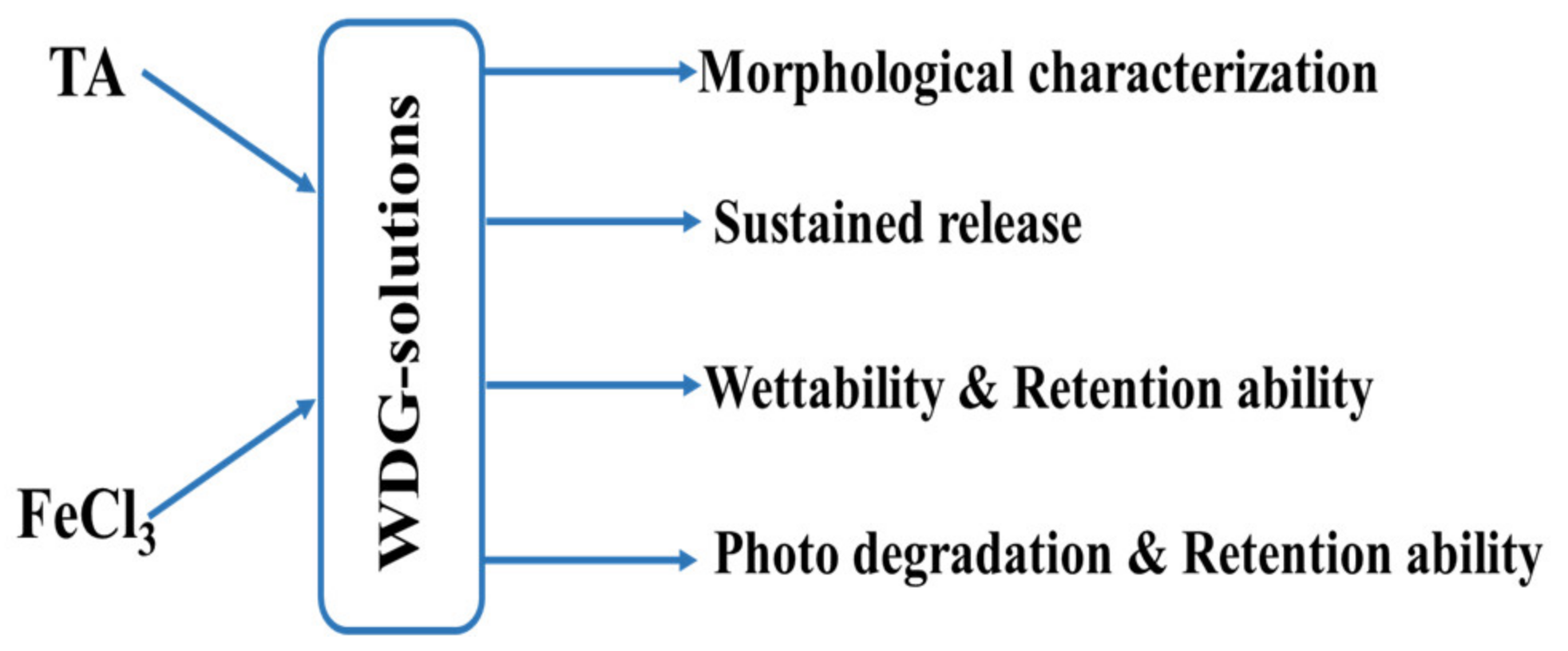
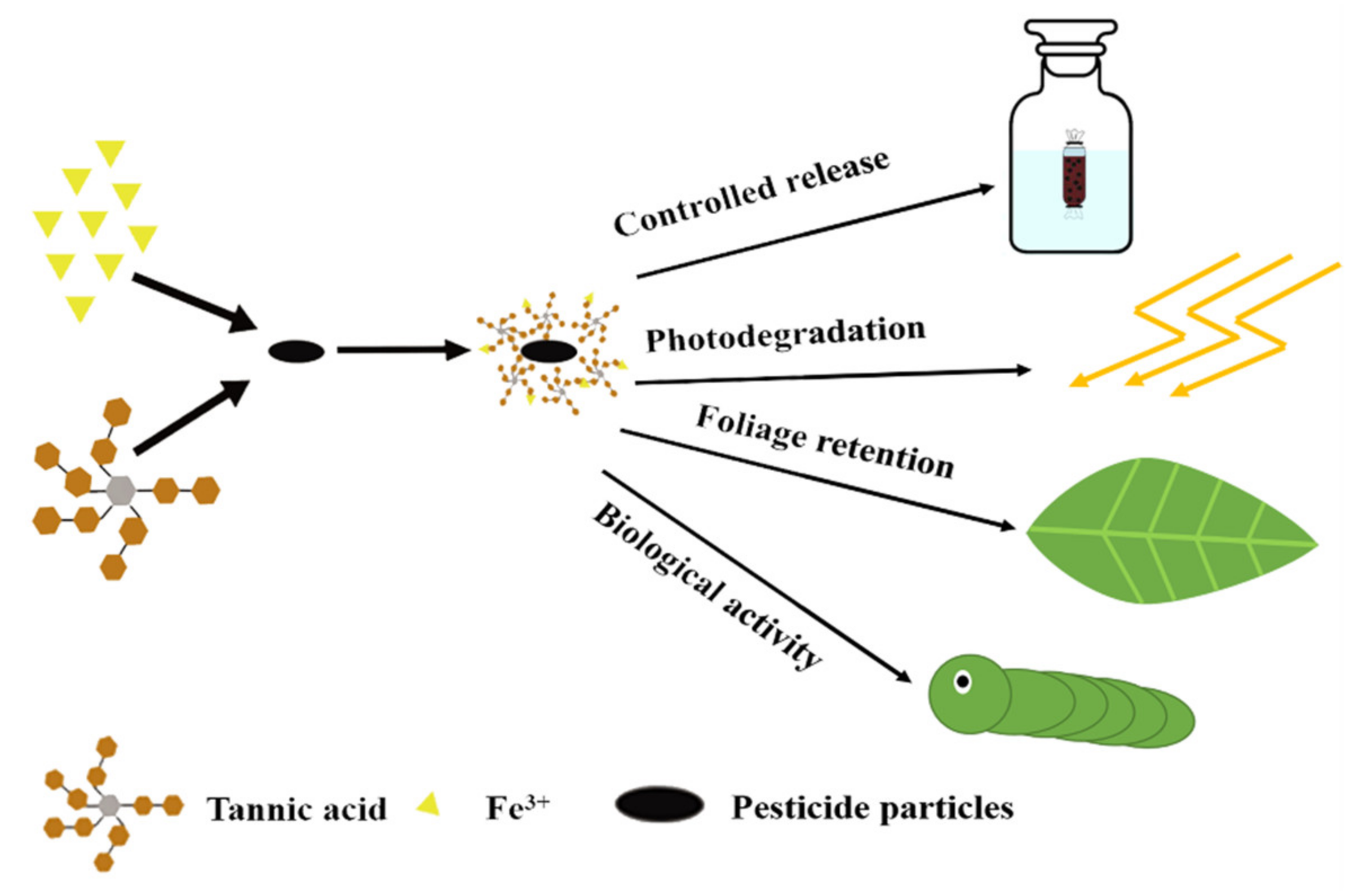
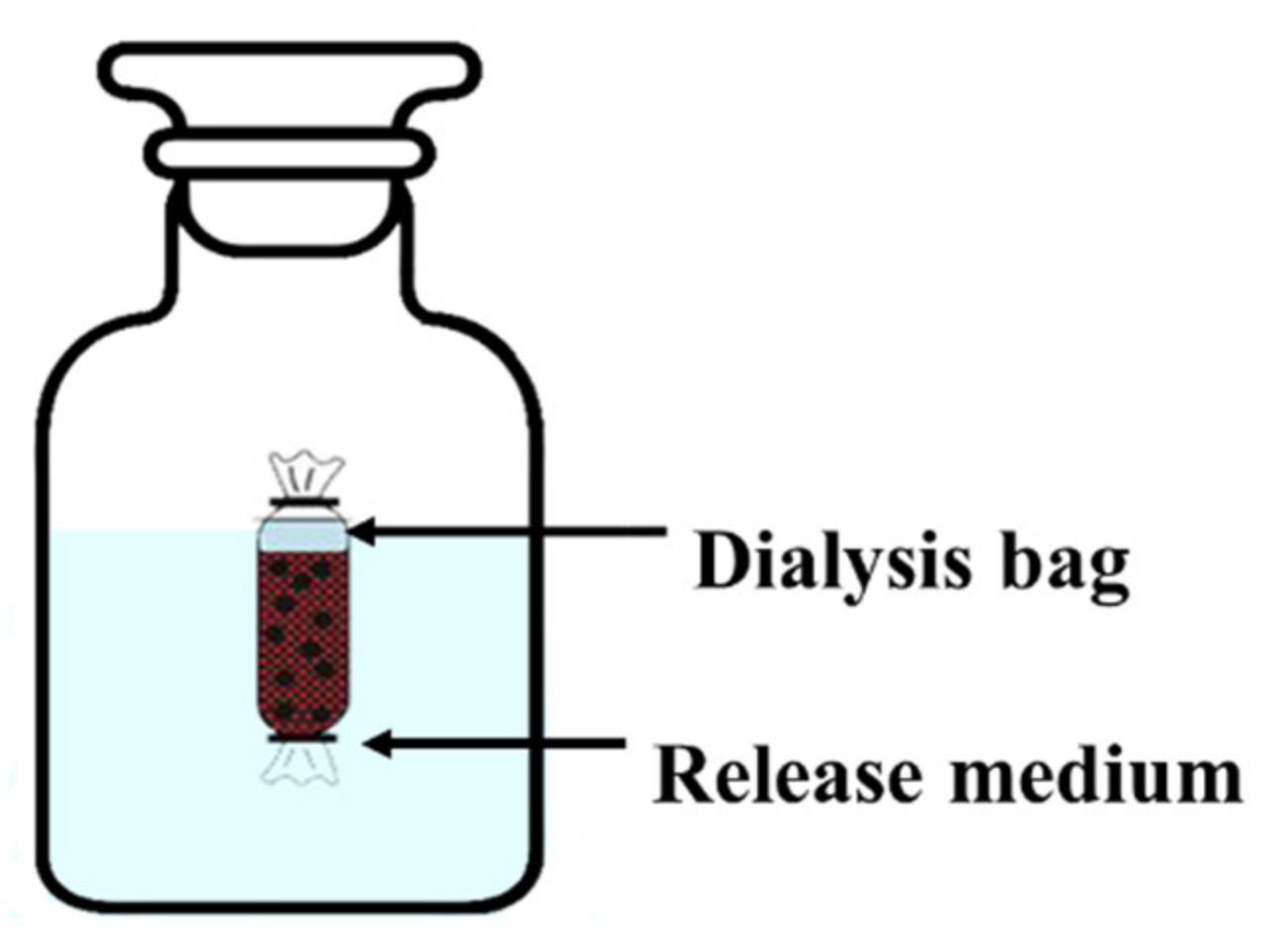
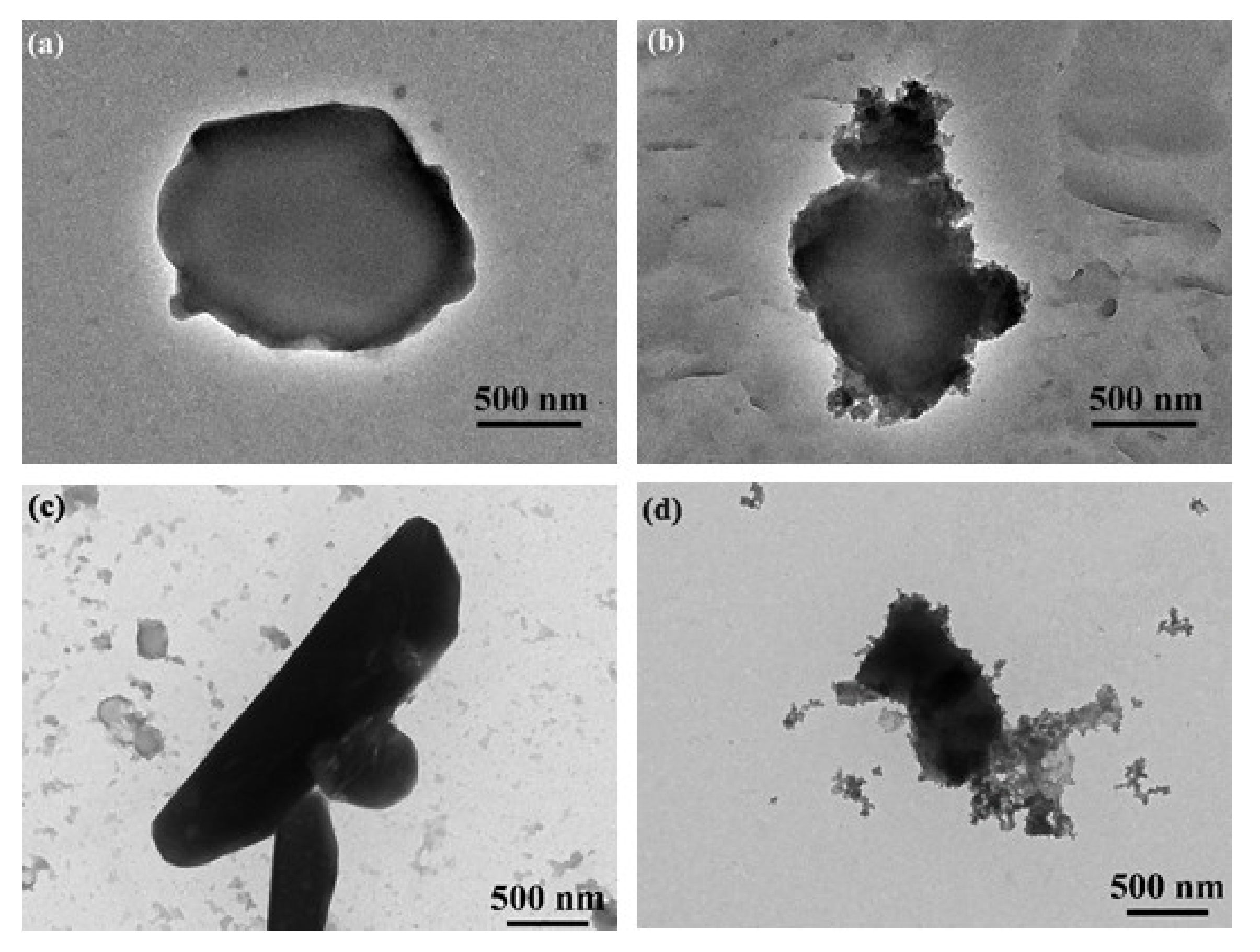
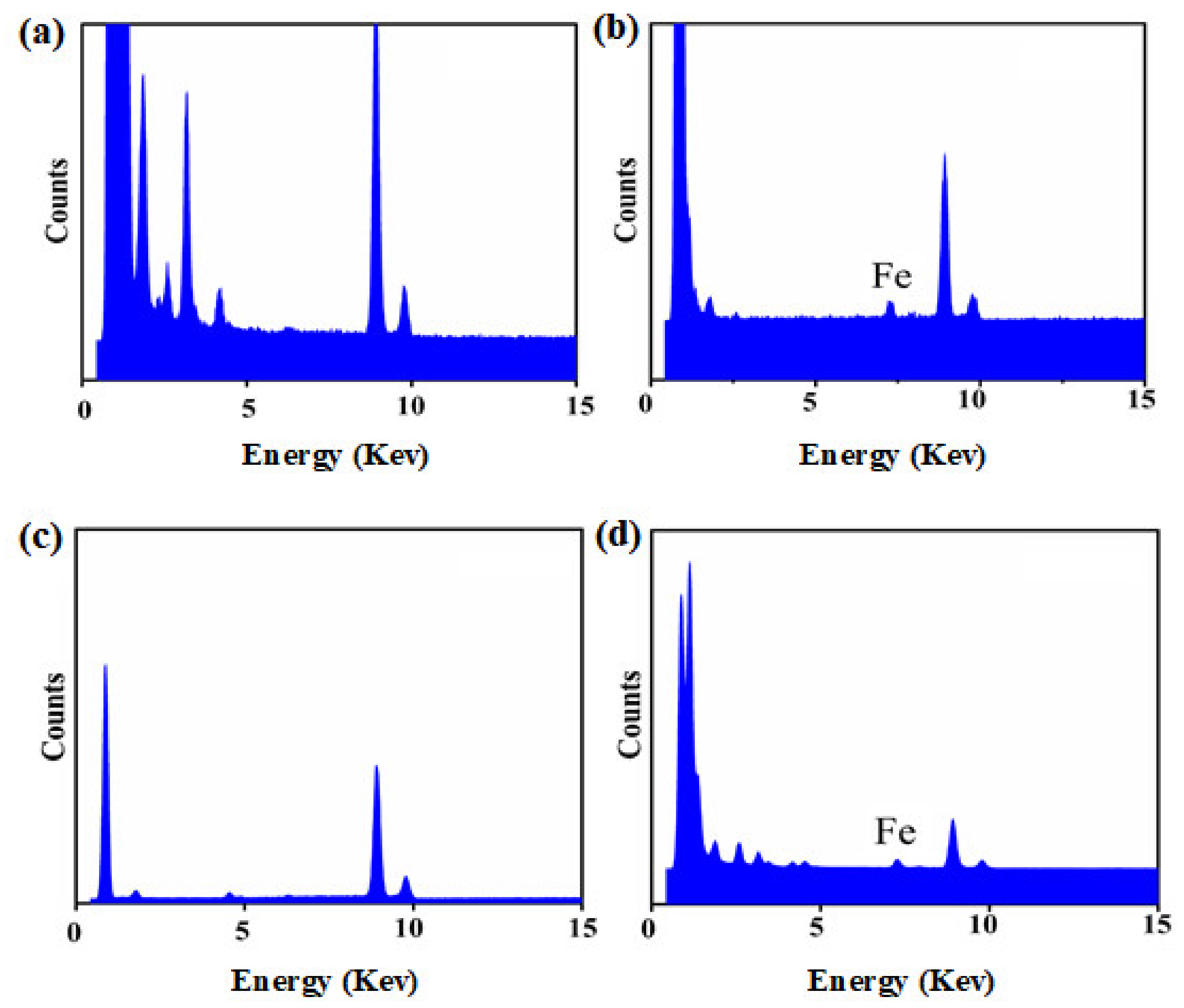
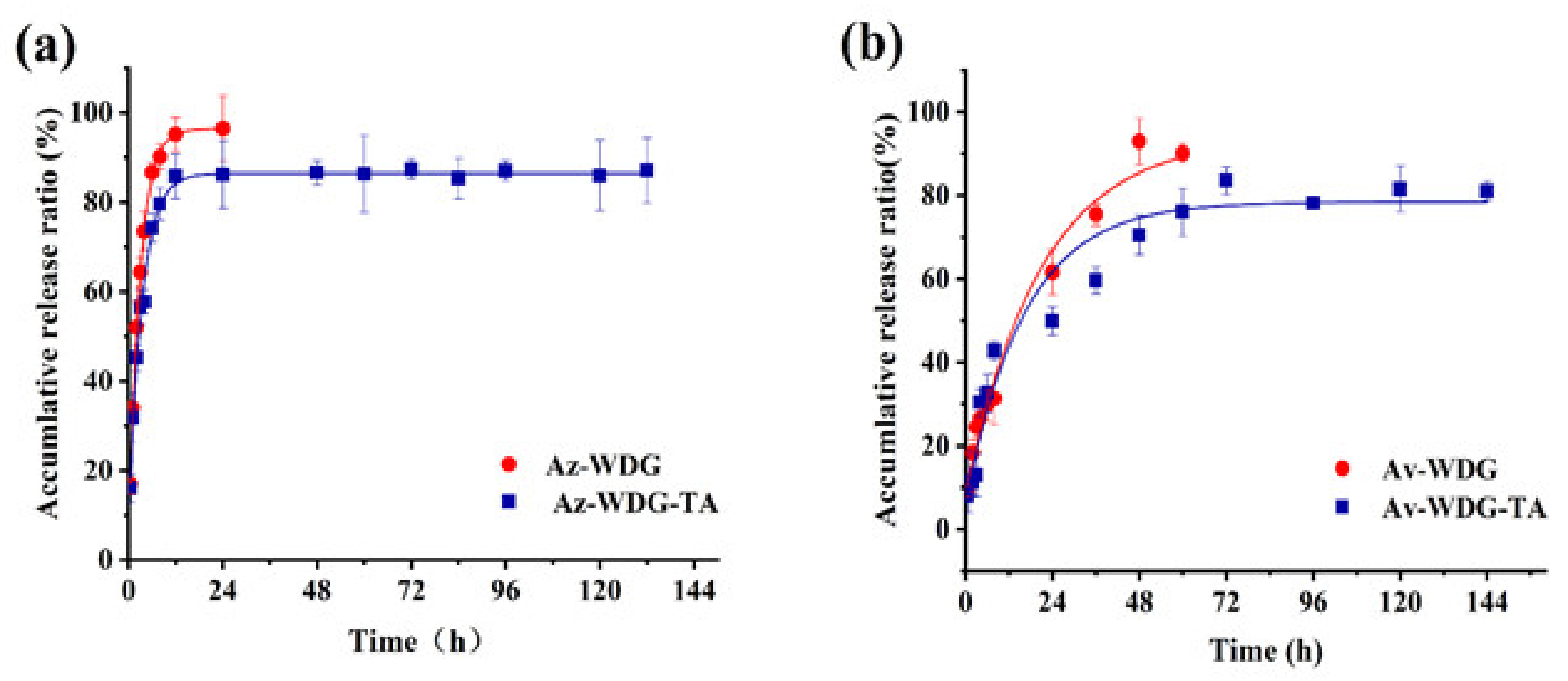




| Formulations | Regression Equation | R2 | LC50 (μg/mL) | Toxicity Index |
|---|---|---|---|---|
| Av-WDG | y = 3.91 + 1.65x | 0.965 | 4.7 | 1 |
| Av-WDG-TA | y = 4.25 + 1.49x | 0.946 | 3.2 | 1.5 |
| Formulations | Regression Equation | R2 | LC50 (μg/mL) | Toxicity Index |
|---|---|---|---|---|
| Az-WDG | y = −0.511 + 0.398x | 0.986 | 19.2 | 1 |
| Az-WDG-TA | y = −0.786 + 0.721x | 0.982 | 12.3 | 1.6 |
© 2020 by the authors. Licensee MDPI, Basel, Switzerland. This article is an open access article distributed under the terms and conditions of the Creative Commons Attribution (CC BY) license (http://creativecommons.org/licenses/by/4.0/).
Share and Cite
Zhi, H.; Yu, M.; Yao, J.; Sun, C.; Cui, B.; Zhao, X.; Wang, Y.; Cui, H.; Zeng, Z. A Facile Approach to Increasing the Foliage Retention of Pesticides Based on Coating with a Tannic Acid/Fe3+ Complex. Coatings 2020, 10, 359. https://doi.org/10.3390/coatings10040359
Zhi H, Yu M, Yao J, Sun C, Cui B, Zhao X, Wang Y, Cui H, Zeng Z. A Facile Approach to Increasing the Foliage Retention of Pesticides Based on Coating with a Tannic Acid/Fe3+ Complex. Coatings. 2020; 10(4):359. https://doi.org/10.3390/coatings10040359
Chicago/Turabian StyleZhi, Heng, Manli Yu, Junwei Yao, Changjiao Sun, Bo Cui, Xiang Zhao, Yan Wang, Haixin Cui, and Zhanghua Zeng. 2020. "A Facile Approach to Increasing the Foliage Retention of Pesticides Based on Coating with a Tannic Acid/Fe3+ Complex" Coatings 10, no. 4: 359. https://doi.org/10.3390/coatings10040359
APA StyleZhi, H., Yu, M., Yao, J., Sun, C., Cui, B., Zhao, X., Wang, Y., Cui, H., & Zeng, Z. (2020). A Facile Approach to Increasing the Foliage Retention of Pesticides Based on Coating with a Tannic Acid/Fe3+ Complex. Coatings, 10(4), 359. https://doi.org/10.3390/coatings10040359








